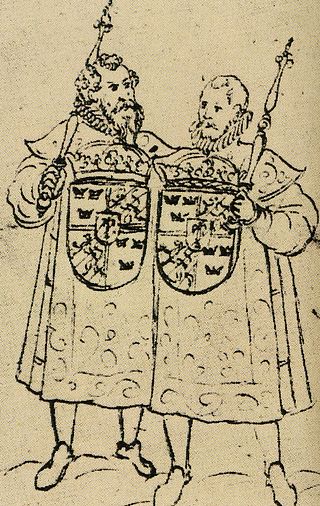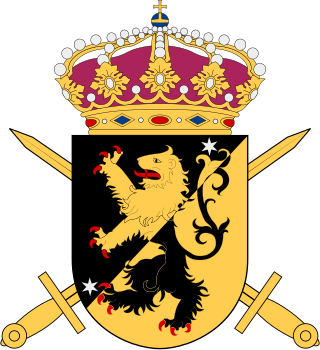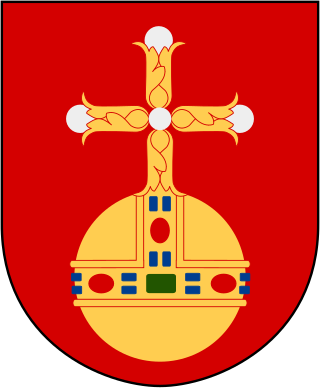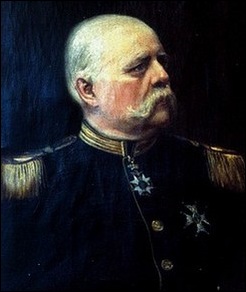Related Research Articles

Västmanland is a historical Swedish province, or landskap, in middle Sweden. It borders Södermanland, Närke, Värmland, Dalarna and Uppland.

Öland is a province of Sweden and, like many of Sweden's provinces, was granted a coat of arms in preparation for the funeral of Gustav Vasa in 1560. Confusion arose between Öland's arms with one deer and Åland's arms with two deer and nine roses, resulting in Öland bearing the wrong coat of arms from the 1880s until an audit in 1944.

The coat of arms of Åland features a golden red deer on a blue field. This is traditionally surmounted by a comital coronet of the elder Swedish style.

An officer of arms is a person appointed by a sovereign or state with authority to perform one or more of the following functions:

The Västerbotten Regiment, designations I 19, I XIX, I 20 and I 20/Fo 61, was a Swedish Army infantry regiment that traced its origins back to the 16th century. The regiment's soldiers were originally recruited from the province of Västerbotten, where it was later garrisoned. The unit was disbanded as a result of the disarmament policies set forward in the Defence Act of 2000.

Swedish heraldry encompasses heraldic achievements in modern and historic Sweden. Swedish heraldic style is consistent with the German-Nordic heraldic tradition, noted for its multiple helmets and crests which are treated as inseparable from the shield, its repetition of colours and charges between the shield and the crest, and its scant use of heraldic furs. Because the medieval history of the Nordic countries was so closely related, their heraldic individuality developed rather late. Swedish and Finnish heraldry have a shared history prior to the Diet of Porvoo in 1809; these, together with Danish heraldry, were heavily influenced by German heraldry. Unlike the highly stylized and macaronic language of English blazon, Swedish heraldry is described in plain language, using only Swedish terminology.

The Skaraborg Regiment, designation I 9, was a Swedish Army infantry regiment that traced its origins back to the 16th century. It was converted to an armoured regiment in 1942. The regiment's soldiers were recruited from Skaraborg County, and it was later garrisoned there.

The Parachute Ranger School, is the Swedish Army's paratrooper ranger school and the home of Fallskärmsjägarna and Särskilda operationsgruppen. The school was founded in 1952 by captain Nils-Ivar Carlborg with the intention of creating and training small specialized units no bigger than platoons which were capable of operating deep behind enemy lines and inside enemy-controlled territory. Training is provided for both normal and static line jumps using the C-130 Hercules aircraft, as well as nighttime jumps, free fall jumps, HALO and HAHO. The school was reorganized into the 323rd Parachute Ranger Company in 2009.

The Svea Artillery Regiment, designation A 1, was a Swedish Army artillery regiment that traced its origins back to the 17th century. It was disbanded in 1997. The regiment's soldiers were originally recruited from Svealand, and it was also garrisoned there.

The Wendes Artillery Regiment, designation A 3, was a Swedish Army artillery regiment that traced its origins back to the 17th century. The regiment's soldiers were originally recruited from Scania, where it was garrisoned. The unit was disbanded as a result of the disarmament policies set forward in the Defence Act of 2000.

The Norrland Dragoon Regiment, also K 4, is a Swedish Army unit specialized in arctic warfare and special operations. Located in the province of Lappland, it was historically a cavalry unit that traces its origins back to the 17th century.

The Schantz family is a noble family of German origin in the Swedish and Finnish Houses of Nobility. They are listed as Family Number 1255 by the Swedish House of Nobility, and as Number 95 by the Finnish House of Nobility. The family was knighted in Sweden in 1693 and was immatriculated in to the Finnish nobility in 1818.
A heraldic authority is defined as an office or institution which has been established by a reigning monarch or a government to deal with heraldry in the country concerned. It does not include private societies or enterprises which design and/or register coats of arms. Over the centuries, many countries have established heraldic authorities, and several still flourish today.
Henrik Teofilus Scheffer was a Swedish chemist notable for his contribution to the discovery of platinum.

The Coat of arms of Gothenburg consists of images from Sweden's great coat of arms and is meant to symbolize the city as Sweden's western defence. The lion is from the arms of the Folkunga dynasty, which in the 17th century was considered to be the arms of Götaland and it holds the arms of Sweden, three crowns, defending this with a sword. The oldest description of the arms is from a letters patent from 1607.

Artillery Staff in the Swedish Army consisted of commanding officers from the artillery units and had the task of assisting the Master-General of the Ordnance and the Inspector of Artillery in all his activities related questions. It was active between 1807 and 1937.

The coat of arms of Uppland in Sweden is Gules, an orb or. The coat of arms is surmounted by a duke's coronet, as are the other Swedish regional coats of arms.

The Småland Artillery Regiment, designation A 6, was a Swedish Army artillery regiment raised in 1895. It was disbanded in 1985. The regiment was based in Jönköping.

Herman Ludvig von Hohenhausen, was a Swedish military colonel and a member of the von Hohenhausen Swedish noble family.

Davor Zovko is a Swedish and Croatian scientist, author, heraldist, musician and knight, who serves as State Herald of Sweden since 2022.
References
- ↑ Gullberg, Ingvar E. (1977). Svensk-engelsk fackordbok för näringsliv, förvaltning, undervisning och forskning [A Swedish-English dictionary of technical terms used in business, industry, administration, education and research] (in Swedish) (2nd ed.). Stockholm: Norstedt. p. 886. ISBN 91-1-775052-0. SELIBR 8345587.
- ↑ Perić, Matija (2022-06-18). "Veliko priznanje: Mostarac Davor Zovko novi je državni herald Kraljevine Švedske". Večernji list (in Croatian). Retrieved 2022-07-14.
- ↑ Raneke, Jan (1990). Svensk adelsheraldik. Malmö: Corona. P. 12. ISBN 91-564-0966-4
- ↑ Kleberg, H.J.S. (1933). Riksheraldikerämbetets uppkomst och utveckling. Messages from Riksheraldikerämbetet. Malmö: Skånetryckeriets förlag. P. 8.
- ↑ Kleberg, p. 9; Raneke, p. 12.
- ↑ Scheffer, C.G.U. (1967). Svensk vapenbok för landskap, län och städer. Stockholm: Generalstabens litografiska anstalts förlag. Pp. 14 and 27.
- ↑ Nevéus, Clara; Bror Jacques de Wærn (1991). Ny svensk vapenbok. Stockholm: Streiffert. Pp. 17, 35 and 44. ISBN 91-7886-092-X
- ↑ Andersson, Per (1989). Heraldiska vapen i Sverige. Mjölby: Draking. P. 21. ISBN 91-87784-00-9
- ↑ Andersson, p. 23.
- ↑ Bäckmark, Magnus; Jesper Wasling (2001). Heraldiken i Sverige. Lund: Historiska media. P. 95. ISBN 91-89442-32-6